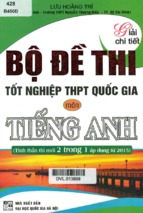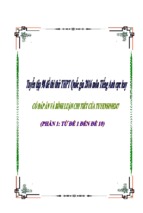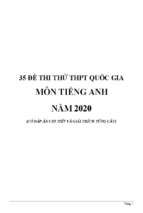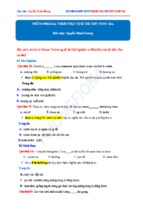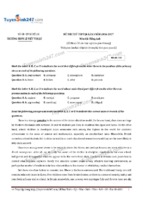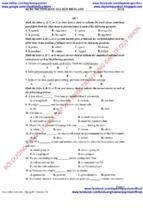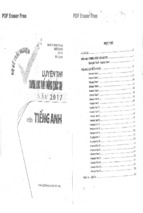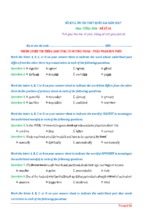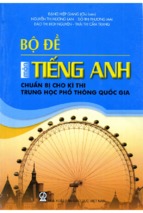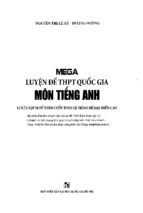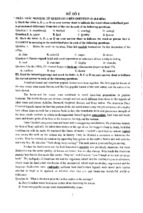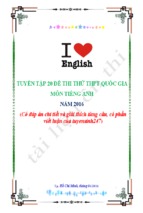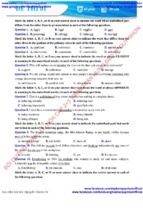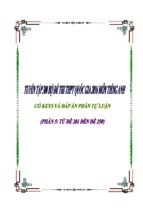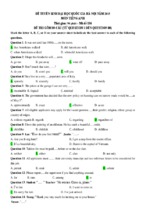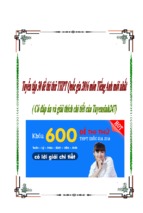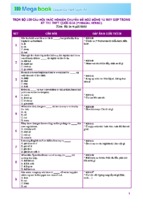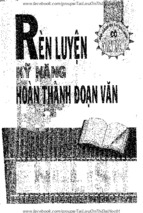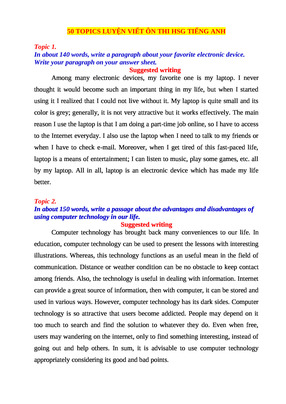BỘ GIÁO DỤC VÀ ĐÀO TẠO
ĐỀ CHÍNH THỨC
ĐỀ THI TUYỂN SINH ĐẠI HỌC NĂM 2009
Môn: TIẾNG ANH; Khối D
Thời gian làm bài: 90 phút, không kể thời gian phát đề
ĐỀ THI GỒM 80 CÂU (TỪ QUESTION 1 ĐẾN QUESTION 80)
I. Mark the letter A, B, C, or D on your answer sheet to indicate the word whose main
stress is placed differently from that of the rest in each of the following questions.
Question 1
A. protect
B. settle
C. relate
D. compose
Trọng âm của từ "settle" rơi vào âm tiết thứ nhất. Trọng âm của các từ còn lại rơi vào âm
tiết thứ hai.
(A: /prə'tekt/, B: /'setl/, C: /rɪ'leɪt/, D: /kəm'pəʊz /)
Question 2
A.elephant
B. buffalo
C. mosquito
D. dinosaur
Trọng âm của từ "mosquito" rơi vào âm tiết thứ hai, còn trọng âm của các từ còn lại rơi
vào âm tiết đầu tiên.
(A: /'elɪfənt/, B: /'bʌfələʊ/, C: /mə'skiːtəʊ/, D: /'daɪnəsɔː(r)/)
Question 3
A.supervisor
B. dictionary
C. catastrophe
D. agriculture
Trọng âm của từ "catastrophe" rơi vào âm tiết thứ hai, còn trọng âm của các từ còn lại rơi
vào âm tiết đầu tiên.
(A: /'suːpəvaɪzə(r) /, B: /'dɪkʃənri/, C: /kə'tæstrəfi/, D: /'æɡrɪkʌltʃə(r)/)
Question 4
A.abnormal
B. innocent
C. initial
D. impatient
Trọng âm của từ "innocent" rơi vào âm tiết đầu, còn trọng âm của các từ còn lại rơi vào
âm tiết thứ hai.
(A: /æb'nɔːml /, B: /'ɪnəsnt/, C: /ɪˈnɪʃl/, D: /ɪm'peɪʃnt /)
Question 5
A.fashionable
B. convenient
C. significant
D. traditional
Trọng âm của từ "fashionable" rơi vào âm tiết đầu tiên, còn trọng âm của các từ còn lại
rơi vào âm tiết thứ hai.
(A: /'fæʃnəbl/, B: /kən'viːniənt /, C: /sɪɡˈnɪfɪkənt/, D: /trə'dɪʃənl/)
II. Mark the letter A, B, C, or D on your answer sheet to indicate the correct answer to
each of the following questions.
Question 6:– “Mum, I’ve got 600 on the TOEFL test.”
– “______”
A.Good job!
B. You are right.
C.Good way!
D. Oh, hard luck!
- Đây là dạng bài về chức năng giao tiếp.
- Câu đề đưa ra là một lời thông báo. Câu sau sẽ là một câu bình luận, xét về ý nghĩa và
cấu trúc thì A là đáp án đúng nhất.
Question 7: My mother told me to ______ for an electrician when her fan was out of
order.
A. send
B. write
C. turn
D. rent
-Cấu trúc "send for somebody" có nghĩa là nhắn ai đến, cho người mời ai đến
Câu này sẽ có nghĩa là: "Mẹ tôi dặn tôi mời thợ điện đến khi cái quạt của bà bị hỏng.
Question 8: Through an ______, your letter was left unanswered.
A.oversight
B. overcharge
C. overtone
D. overtime
- oversight: sai sót/ thiếu sót/ quên
- overcharge: sự nạp quá điện/ sự bán quá đắt
- overtone: âm bội (trong âm nhạc)
- overtime: giờ làm thêm.
=> Đáp án đúng là "Through an oversight" - Vì/ do/ tại sai sót
Question 9: “How many times have I told you ______ football in the street?”
A. not to have played
B. not playing
C. not to play
D. do not play
- Cấu trúc câu khẳng định "tell somebody to do something - yêu cầu ai đó làm gì" và phủ
định là "tell somebody not to do something"
Question 10: He ______ to the doctor after the accident, but he continued to play
instead.
A. must have gone
B. didn’t have to go
C. should have gone
D. couldn’t go
- Cấu trúc "should have + PP" - một việc đáng lẽ ra nên làm nhưng lại không làm trong
quá khứ.
- Cấu trúc "must have + PP" - một phỏng đoán/ một kết luận trong quá khứ.
Question 11: The United States consists of fifty states, ______ has its own government.
A. each of that
B. they each
C. hence each
D. each of which
- Trong phần bài ôn tập về đại từ quan hệ chúng ta có chú ý sau: "Các từ chỉ số lượng: all
of, some of, many of, most of, none of, each of… và các tính từ so sánh hơn và so sánh
nhất có thể đứng trước đại từ quan hệ whom, hoặc which."
- Câu gốc sẽ là "each of them" và "them" ở đây là thay thế của danh từ "fifty states" đã
nhắc đến ở mệnh đề trước.Vì là thay thế cho danh từ chỉ sự vật sự việc nên chúng ta sẽ
dùng đại từ quan hệ "which".
Question 12: “Don’t worry. I have ______ tire at the back of my car.”
A. other
B. others
C. the other
D. another
- Ta có "other + N" có nghĩa là người kia, vật kia (so sánh hai đối tượng).
- "another + N" có nghĩa là một cái khác nữa.
- "others" có nghĩa là những cái khác/ những vật khác
Question 13:There was nothing they could do ______ leave the car at the roadside where
it had broken down.
A. unless
B. than
C. but
D. instead of
- but : trong trường hợp này được dịch là "ngoài việc/ trừ" = exept for. Trong câu này
dùng "but" là hợp nghĩa và cấu trúc hơn cả.
- unless + mệnh đề
- instead of + V-ing
Question 14:Lora: “Your new blouse looks gorgeous, Helen!”
Helen: “______.”
A. You can say that again
B. Thanks, I bought it at Macy’s
C. It’s up to you
D. I’d rather not
- Đây là bài về chức năng giao tiếp.
- Câu đề đưa ra là một lời khen ngợi. Do đó, câu trả lời phù hợp chỉ có thể là B
Question 15: Only when you grow up ______ the truth.
A. will you know
B. you will know
C. do you know
D. you know
- Ta có cấu trúc mệnh đề với "when" là
+ "when(ever) + S + V (hiện tại đơn), S + will + V..."
+ "when(ever) + S + V(quá khứ đơn), S + would + V..."
- Như vậy trong trường hợ này mệnh đề sau sẽ phải là "will + V" nhưng vì khi trạng từ
"only" đứng đầu thì xuất hiện hiện tượng đảo ngữ => Đáp án đúng là A
Question 16:– “Don’t fail to send your parents my regards.”
– “______.”
A. Good idea, thanks
B. It’s my pleasure
C. You’re welcome
D. Thanks, I will
- Đây là bài về chức năng giao tiếp.
- Câu đề đưa ra là :Đừng quên chuyển lời chúc sức khỏe của tớ đến bố mẹ bạn nhé
- Vậy câu trả lời phù hợp nhất sẽ là phải là D: Cảm ơn bạn, nhất định tớ sẽ chuyển rồi.
Question 17: “This library card will give you free access ______ the Internet eight hours
a day.”
A. to
B. in
C. from
D. on
- access to something: tiếp cận/ truy cập/ kết nối với ...
Question 18:– “Should we bring a lot of money on the trip?”
– “Yes. ______ we decide to stay longer.”
A. Because
B. So that
C. Though
D. In case
- In case: phòng khi
Dịch hai câu này là: - Chúng ta có nên mang theo nhiều tiền khi đi du ngoạn không nhỉ?
- Có chứ. Phòng khi chúng ta muốn đi chơi lâu hơn.
Question 19: ______ he arrived at the bus stop when the bus came.
A. No sooner had
B. Not until had
C. No longer has
D. Hardly had
- Cấu trúc "Hardly had + S + PP ...when + S + V (quá khứ đơn)" - có nghĩa là ngay sau
khi .... thì/ là....
=>Câu này dịch là: Ngay sau khi anh ta đến bến xe buýt thì chiếc xe buýt đến.
Question 20:John: “Do you think that we should use public transportation to protect our
environment?”
Laura: “______”
A. Well, that’s very surprising.
B. Of course not. You bet!
C.Yes, it’s an absurd idea.
D. There’s no doubt about it.
- Đây là dạng bài về chức năng giao tiếp.
- Câu hỏi đưa ra hàm ý là một lời gợi ý và câu trả lời đưa ra "There's no doubt about it" "không có gì phải nghi ngời về điều đó" là lời đáp phù hợp nghĩa nhất.
- Well, that’s very surprising: Ôi thật ngạc nhiên
- Of course not. You bet!: tất nhiên là không rồi. A đánh cuộc đi!
- Yes, it’s an absurd idea: Ừ đúng là một ý tưởng ngớ ngẩn.
Question 21: Susan’s doctor insists ______ for a few days.
A. her resting
B. that she is resting
C. that she rest
D. her to rest
- Cấu trúc "to insist on doing something/ to insist that someone do something" - khăng
khăng làm gì/ khăng khăng yêu cầu ai làm gì
=> C là đáp án chính xác nhất.
Question 22: “I’d rather you______ home now.”
A.went
B. go
C. gone
D. going
- Cấu trúc với "would rather + that + S + V (quá khứ)..." dùng để diễn tả câu giả định
không có thật ở hiện tại. Nếu động từ là "to be" thì sẽ chia là "were" với tất cả các ngôi.
Question 23: “Please, will you just tidy your room, and stop ______ excuses!”
A. taking
B. having
C. doing
D. making
- Cấu trúc "make an excuse: xin lỗi"
Question 24: John paid $2 for his meal, ______ he had thought it would cost.
A. not so much as
B. not so many as
C. not as much
D. less as
- Đây là bài về cấu trúc của so sánh bằng thì mới phù hợp nghĩa. Do vậy, đáp án C và D
bị loại. Đây là so sánh về tiền - không đếm được nên phải dùng "much".=> Đáp án đúng
là A.
- Câu này dịch là: "John phải trả 2 đô la cho bữa ăn, không tốn nhiều tiền như anh ta đã
nghĩ."
Question 25: Jane ______ law for four years now at Harvard.
A. studies
B. studied
C. has been studying
D. is studying
- Nội dung của câu văn dùng để nhấn mạnh đến thời gian học luật của Jane ở Harvard là
4 năm. Do đó ta phải dùng thì hiện tại hoàn thành tiếp diễn và C là đáp án đúng nhất.
Question 26:– “How do you like your steak done?”
– “ ______.”
A.Very much
B. Well done
C. I don’t like it much
D. Very little
- Đáp án B : well done (chín kỹ) là đáp án thích hợp nhất cho câu hỏi "Bạn thích món thịt
bò được chế biến thế nào?"
Question 27:The kitchen ______ dirty because she has just cleaned it.
A. may be
B. should be
C. can’t be
D. mustn’t be
- Chúng ta dùng "can't be" để diễn tả khả năng không thể xảy ra của một sự việc.
- Dịch câu trên là: Nhà bếp không thể bẩn được bởi vì cô ấy vừa lau nó mà.
Question 28:She had to hand in her notice ______ advance when she decided to leave
the job.
A. in
B. with
C. from
D. to
-Cấu trúc "in advance" có nghĩa là trước (về mặt thời gian).
- hand in her notice in advance : nộp đơn thôi việc trước
Question 29: We couldn’t fly ______ because all the tickets had been sold out.
A. economic
B. economy
C. economical
D. economics
- Cấu trúc "fly economy" có nghĩa là "đi máy bay ngồi ghế tiết kiệm/ rẻ tiền
Question 30: There should be an international law against ______.
A. afforestation
B. forestry
C. reforestation
D. deforestation
- afforestation: sự trồng cây gây rừng
-forestry : lâm nghiệp
-reforestation: tái trồng rừng
-deforestation: tàn phá rừng
Dựa vào nghĩa của câu chúng ta có đáp án D là đáp án thích hợp nhất
Question 31: They didn’t find ______ in a foreign country.
A.it easy live
B. easy to live
C. it easy to live
D. it to live easy
- Ta có cấu trúc : "find it + adjective + to V" nhận thấy ... để làm gì....
Question 32: The forecast has revealed that the world’s reserves of fossil fuel will have
______ by 2015.
A.used off
B. taken over
C. run out
D. caught up
-used off: sử dụng hết
- taken over: đảm nhiệm
- caught up : bắt kịp
- run out : cạn kiệt
=> Đáp án đúng là C
- Dịch cả câu là : Dự báo rằng nguồn nguyên liệu dự trữ của thế giới sẽ cạn kiệt vào năm
2015.
Question 33: I won’t change my mind ______ what you say.
A.whether
B. no matter
C. because
D. although
- no matter what = what ever + S + V (hiện tại): dù ... có... như thế nào
Question 34: It is very important for a firm or a company to keep ______ the changes in
the market.
A.touch with
B. up with
C. track about
D. pace of
-keep up with = come up with : bắt kịp
Question 35: “Buy me a newspaper on your way back, ______?”
A.do you
B. can’t you
C. don’t you
D. will you
-Cấu trúc câu hỏi đuôi với câu mệnh lệnh/ câu cầu khiến là "will you"
III. Mark the letter A, B, C, or D on your answer sheet to indicate the sentence that is
closest in meaning to each of the following questions.
Question 36: It doesn’t matter to them which film they go to.
A. Which film they go to matters more than the cost.
B. They don’t mind which film they go to.
C. Whatever films are shown, they never see.
D. They don’t care about the cost of the films they see.
-Cấu trúc giới thiệu câu "it doesn't matter to" có nghĩa là chẳng vấn đề gi/ chẳng quan
trọng gì. Câu này có nghĩa là "Họ xem phim gì cũng được".
=>B là đáp án đúng nhất: Họ không quan tâm đến việc họ sẽ xem bộ phim nào.
Question 37: “Please don’t drive so fast, Tom,” said Lisa.
A. Lisa complained about Tom’s driving too fast.
B. Lisa insisted on Tom’s driving on.
C. Lisa pleaded with Tom not to drive too fast.
D. Lisa grumbled to Tom about driving slowly.
-Câu đề là "làm ơn đừng lái xe quá nhanh như thế, Tom"
- Đây là lời nói mang ngụ ý nài nỉ, do vậy ở các đáp án sau chỉ có đáp án C là phù hợp
nghĩa.
- Nghĩa của đáp án C là: Lisa nài nỉ Tom đừng lái xe quá nhanh.
Question 38: He talked about nothing except the weather.
A. He had nothing to say about the weather.
B. He said that he had no interest in the weather.
C. His sole topic of conversation was the weather.
D. He talked about everything including the weather.
- Cụm từ "talk about nothing except" - chỉ nói chuyện về ... gần nghĩa với cấu trúc "sole
topic"- chủ đề duy nhất của buổi nói chuyện.
Question 39:He survived the operation thanks to the skilful surgeon.
A. He survived because he was a skilful surgeon.
B.There was no skilful surgeon, so he died.
C. He wouldn’t have survived the operation without the skilful surgeon.
D.Though the surgeon was skilful, he couldn’t survive the operation.
- Câu đề là : Anh ta đã sống sót nhờ bác sỹ phẫu thuật lành nghề.
- Đáp án A : không hợp nghĩa
- Đáp án B : khác nghĩa hoàn toàn
- Đáp án C: trái nghĩa
=> D là đáp án đúng. Đây là hình thức của câu điều kiện loại 3- mệnh đề giả định không
có thật ở quá khứ."Nếu không có bác sỹ phẫu thuật lành nghế thì anh ta đã không thể
sống sót."
Question 40:She said, “John, I’ll show you round my city when you’re here.”
A. She made a trip round her city with John.
B. She planned to show John round her city
C. She organized a trip round her city for John.
D. She promised to show John round her city.
- Đây là dạng câu tường thuật với động từ đặc biệt, do vậy chúng ta cần hiểu đúng nội
dung để dùng đúng động từ phù hợp.
=> Ở đây D là đáp án phù hợp nhất với động từ "promise".
Question 41:The film didn’t come up to my expectations.
A. I expected the film to end more abruptly.
B. I expected the film to be more boring.
C. The film was as good as I expected.
D. The film fell short of my expectations.
- Cấu trúc "not to come up to one's expectation = to fall short of one's expectation: không
được tốt đẹp như ai đó mong đợi.
Question 42:There’s no point in persuading Jane to change her mind.
A. Jane will change her mind though she doesn’t want to.
B. It’s useless to persuade Jane to change her mind.
C. It’s possible for us to persuade Jane to change her mind.
D. No one wants Jane to change her mind because it’s pointless.
- Cấu trúc "there's no point in doing something = It's useless to do something : Vô ích khi
làm gì"
Question 43:James was the last to know about the change of schedule.
A. Everyone had heard about the change of schedule before James did.
B. Among the last people informed of the change of schedule was James.
C. The last thing James knew was the change of schedule.
D. At last James was able to know about the change of schedule.
- Câu đề là : James là người cuối cùng biết sự thay đổi của kế hoạch làm việc
Chỉ có đáp án A là có nghĩa tương đương với câu đề ra : Mọi người đã đều nghe về sự
thay đổi của kế hoạch làm việc trước khi James biết.
Question 44:Peter had very little money but managed to make ends meet.
A. Peter found it hard to live on very little money.
B. Having little money, Peter couldn’t make ends meet.
C. Peter could hardly live on little money.
D. Peter got by on very little money.
- Cấu trúc "get by on = manage" : xoay sở. Có nghĩa là Peter xoay sở được dù với số tiền
rất ít.
Question 45:“Why don’t you reply to the President’s offer right now?” said Mary to her
husband.
A. Mary wondered why her husband didn’t reply to the President’s offer then.
B. Mary suggested that her husband should reply to the President’s offer without
delay.
C. Mary ordered her husband to reply to the President’s offer right now.
D. Mary told her husband why he didn’t reply to the President’s offer then.
- Cấu trúc "Why don't + S + V (nguyên thể) ..." thể hiện sự gợi ý ai đó làm gì.
=> B là đáp án chính xác nhất.
V. Mark the letter A, B, C, or D on your answer sheet to show the underlined part that
needs correction in each of the following questions.
Question 46:Even though (A) the extremely (B) bad weather in the mountains, the
climbers decided not to cancel (C) their climb (D).
A
B
C
D
-Sau "even though + mệnh đề" nhưng "the extremely bad weather" là cụm danh từ =>
phải dùng "Inspite of" hoặc "Despite"
Question 47: The media have (A) produced live covering (B) of Michael Jackson’s fans
around the world(C) mourning for him (D).
A
B
C
D
- "live" ở đây là tính từ, có nghĩa là "trực tiếp". "covering" cũng là danh từ nhưng ở đây
ta phải dùng danh từ là "coverage" trong cụm danh từ "live coverage" - tin tức trực tiếp.
Question 48: Found (A) in the 12th century, Oxford University ranks (B) among (C) the
world’s oldest universities (D).
A
B
C
D
- "found" ở đây là động từ nguyên thể có nghĩa là "thành lập" nhưng động từ trong câu
này phải được chia ở thể bị động vì chủ ngữ là "Oxford University", nó không thể tự
thành lập được mà phải là được ai đó thành lập. Và vì là đồng chủ ngữ nên câu trên sẽ
được chia là "being founded/ founded" - được thành lập.
Question 49: Although (A) smokers are aware (B) that smoking is harmful to (C) their
health, they can’t get rid it (D).
A
B
C
D
- Cấu trúc "get rid of something" - bỏ/ loại bỏ cái gì. Đáp án D ở đây không có "of" =>
chưa đủ cấu trúc.
Question 50: Bill was about average (A) in performance in (B) comparison with other
students (C) in his (D) class.
A
B
C
D
- Xét phương pháp loại trừ ta thấy các đáp án A,B, D đều đúng. Ta có cấu trúc "other +
danh từ số nhiều/ danh từ không đếm được" có nghĩa là "... còn lại". Trong câu này phải
có "the" trước "other" để ám chỉ số học sinh còn lại, số học sinh này đã được xác định.
=> Đáp án sai ở đây là D và sửa lại thành "with the other students
V. Read the following passage and mark the letter A, B, C, or D on your answer sheet
to indicate the correct word for each of the blanks from 51 to 60.
Some time ago, scientists began experiments to find out (51)______ it would be
possible to set up a “village” under the sea. A special room was built and lowered
(52)______ the water of Port Sudan in the Red Sea. For 29 days, five men lived
(53)______ a depth of 40 feet. At a (54)______ lower level, another two divers stayed for
a week in a smaller “house”. On returning to the surface, the men said that they had
experienced no difficulty in breathing and had (55)______ many interesting scientific
observations. The captain of the party, Commander Cousteau, spoke of the possibility of
(56)______the seabed. He said that some permanent stations were to be set up under the
sea, and some undersea farms would provide food for the growing population of the
world.
The divers in both “houses” spent most of their time (57)______ the bottom of the sea.
On four occasions, they went down to 360 feet and observed many extraordinary
(58)______ of the marine life, some of which had never been seen before. During their
stay, Commander Cousteau and his divers reached a depth of 1,000 feet and witnessed a
gathering of an immense (59)______ of crabs which numbered, perhaps, hundreds of
millions. They also found out that it was (60)______ to move rapidly in the water in a
special vessel known as a “diving saucer”.
Question 51:
A. what
B. which
C. how
D. whether
- Ta có cấu trúc "to find out/ know/ wonder + whether + mệnh đề" có nghĩa là tìm xem/
biết xem/ băn khoăn xem ... liệu ..... có được hay không.
Question 52:
A. down
B. into
C. below
D. underneath
- Cụm giới từ "into the water - ở dưới nước".
Question 53:
A. at
B. in
C. on
D. from
-Cấu trúc "at a/the depth of" có nghĩa là ở độ sâu bao nhiêu.
Question 54:
A. some
B. more
C. any
D. much
-"much" đứng trước tính từ trong so sánh hơn để nhấn mạnh.
Question 55:
A. exercised
B. made
C. caught
D. done
-Cụm từ cố định "make (an) observations = observe: quan sát"
Question 56:
A. cultivating
B. transplanting
C. implanting
D. growing
- cultivating : trồng trọt, canh tác
- transplanting : cấy/ ghép, trồng lại (lúa)
- implanting: đóng sâu vào, cắm chặt vào, ghi khắc, in sâu
- growing: mọc lên, lớn lên, đâm chồi nảy nở
=> A là đáp án chính xác nhất vì ở đây người ta nghĩ đến việc canh tác trồng trọt dưới đáy
biển để cung cấp lương thực cho dân số ngày càng tăng.
Question 57:
A. exploring
B. enquiring
C. inquiring
D. imploring
- Cấu trúc "spend + Ving" cả 4 đáp án đều là V-ing nên ta cần xét về nghĩa.
- exploring : khám phá
- enquiring: Có nghĩa như inquiring
- inquiring: điều tra, thẩm vấn, hỏi thăm
- imploring: cầu khẩn, van xin
=> A là đáp án đúng.
Question 58:
A. breeds
B. forms
C. castes
D. systems
- Ta có cấu trúc "forms of = kinds of" có nghĩa là nhiều loại
Question 59:
A. pack
B. flock
C. school
D. herd
- Đây là cấu trúc từ cố định (collocation) "a school of crabs" = bầy/ đàn cua.
Question 60:
A. able
B. hardly
C. possible
D. capable
- Câu này diễn tả sự phỏng đoán, khả năng có thể xảy ra: "to be possible + to V" - có thể
làm gì.
=> C là đáp án đúng nhất.
VI. Read the following passage and mark the letter A, B, C, or D on your answer sheet
to indicate the correct answer to each of the questions from 61 to 70.
Probably the most famous film commenting on the twentieth-century technology is
Modern Times, made in 1936. Charlie Chaplin was motivated to make the film by a
reporter who, while interviewing him, happened to describe the working conditions in
industrial Detroit. Chaplin was told that healthy young farm boys were lured to the city to
work on automotive assembly lines. Within four or five years, these young men’s health
was destroyed by the stress of work in the factories.
The film opens with a shot of a mass of sheep making their way down a crowded ramp.
Abruptly, the film shifts to a scene of factory workers jostling one another on their
way to a factory. However, the rather bitter note of criticism in the implied comparison is
not sustained. It is replaced by a gentle note of satire. Chaplin prefers to entertain rather
than lecture.
Scenes of factory interiors account for only about one-third of Modern Times, but they
contain some of the most pointed social commentary as well as the most comic situations.
No one who has seen the film can ever forget Chaplin vainly trying to keep pace with the
fast-moving conveyor belt, almost losing his mind in the process. Another popular scene
involves an automatic feeding machine brought to the assembly line so that workers need
not interrupt their labor to eat. The feeding machine malfunctions, hurling food at
Chaplin, who is strapped in his position on the assembly line and cannot escape. This
serves to illustrate people’s utter helplessness in the face of machines that are meant to
serve their basic needs.
Clearly, Modern Times has its faults, but it remains the best film treating technology
within a social context. It does not offer a radical social message, but it does accurately
reflect the sentiment of many who feel they are victims of an over-mechanised world.
Question 61: According to the passage, Chaplin got the idea for Modern Times from
______.
A. fieldwork
B. a conversation
C. a newspaper
D. a movie
-Dựa vào câu thứ hai của đoạn đầu tiên.
Question 62: The young farm boys went to the city because they were ______.
A. attracted by the prospect of a better life
B. driven out of their sheep farm
C. promised better accommodation
D. forced to leave their sheep farm
- Dựa vào câu thứ 3 của đoạn đầu tiên. Động từ "lure = attract" chia ở bị động có nghĩa là
bị cuốn hút/ lôi kéo.
Question 63: The phrase “jostling one another” in the third paragraph is closest in
meaning to “______”.
A hurrying up together
B. jogging side by side
C. running against each other
D. pushing one another
- Cụm từ "jostling one another" có nghĩa là chen lấn/ xô đẩy lẫn nhau => Cụm từ
"pushing one another" là gần nghĩa nhất.
Question 64: According to the passage, the opening scene of the film is intended ______.
A. to introduce the main characters of the film
B. to produce a tacit association
C. to give the setting for the entire plot later
D. to reveal the situation of the factory workers
- Xem câu duy nhất của đoạn thứ 2, ta thấy cảnh đầu của bộ phim là " a mass of sheep
making their way down a crowded ramp" có tác dụng ngụ ý về hình ảnh những người
công nhân nhà máy. Do vậy đáp án B là đáp án chính xác "tacit" nghĩa là ngụ ý/ ẩn ý.
Question 65: The word “vainly” in the fourth paragraph is closest in meaning to
“______”.
A. recklessly
B. carelessly
C. hopelessly
D. effortlessly
"vainly" : vô ích, vô vọng
- recklessly: một cách thiếu thận trọng, một cách dễ dàng
- carelessly: một cách bất cẩn
- effortlessly : một cách dễ dàng
- hopelessly : vô ích, vô vọng
Question 66: The word “This” in the fourth paragraph refers to ______.
- Xem thêm -

